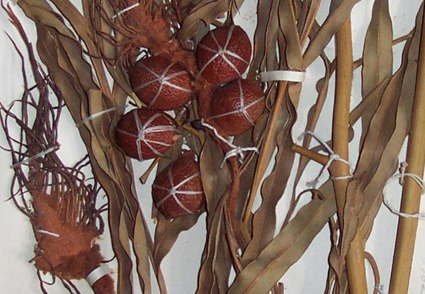Abstract
Traditionally, species delimitation based on morphological and distributional evidence often leads to over- or underestimation of species diversity. The primary distribution area of Cycas debaoensis includes two habitats, which were initially published as two separate species, i.e., C. debaoensis in the karst habitat, and C. panshuiensis, which was originally published as Cycas gracilis Y.Y. Huang, Y.C. Zhong et Z.F. Lu, in the sand habitat. However, field investigations and population sampling in these two habitats revealed a certain degree of morphological transition and variation among the populations. Subsequent population genetic analysis showed minimal genetic differentiation among the populations in the two habitats, suggesting that they should be merged as a single species. Additionally, the typification of the name C. debaoensis is also discussed.
References
- Bösenberg, J.D. (2023) Cycas debaoensis. The IUCN Red List of Threatened Species 2023: e.T42038A68899343. Available from: https://www.iucnredlist.org/en (accessed 19 May 2024)
- Calonje, M., Stevenson, D.W. & Osborne, R. (2024) The World List of Cycads, online edition. Available from: https://cycadlist.org/index.php (accessed 29 April 2024)
- Chen, J.R. & Zhong, Y.C. (1997) Cycas debaoensis Y.C. Zhong et C.J. Chen — A new cycad from China. Acta Phytotaxonomica Sinica 35: 571.
- Gao, Z. & Thomas, B.A. (1989) A review of fossil cycad megasporophylls, with new evidence of Crossozamia Pomel and its associated leaves from the Lower Permian of Taiyuan, China. Review of Palaeobotany and Palynology 60: 205–223. https://doi.org/10.1016/0034-6667(89)90044-4
- Gong, Y.Q. (2015) Genetic Differentiation and Phylogeographic of four bipinnata Cycas species. Dissertation. Kunming Institute of Botany, Chinese Academy of Sciences, 98 pp.
- Gong, Y.-Q. & Gong, X. (2016) Pollen-mediated gene flow promotes low nuclear genetic differentiation among populations of Cycas debaoensis (Cycadaceae). Tree Genetics & Genomes 12: 1–15. https://doi.org/10.1007/s11295-016-1051-6
- Huang, Y.Y. (2018) Studies of the conservation process and taxonomy of Cycas baiseensis and Cycas debaoensis. Memoirs of the New York Botanical Garden 117: 504–518. https://doi.org/10.21135/893275389.032
- Huang, Y.Y., Zhong, Y.C. & Lu, Z.F. (2008) Cycas gracilis Y.Y. Huang, Y.C. Zhong et Z.F. Lu, a new species of Cycas from Guangxi. Journal of Plant Genetic Resources 9: 525–527.
- Linnaeus, C. (1753) Species plantarum. Salvius, Stockholm. 1200 pp.
- Liu, J., Lindstrom, A.J., Marler, T.E. & Gong, X. (2022) Not that young: combining plastid phylogenomic, plate tectonic and fossil evidence indicates a Palaeogene diversification of Cycadaceae. Annals of Botany 129: 217–230. https://doi.org/10.1093/aob/mcab118
- Lu, Z.F., Yang, R.Q., Liang, L., Luo, B. & Zhong, Y.C. (2004) Ecological types of Cycas debaoensis. In: Cycas Society, Botanical Society of China (Org.) A compilation of abstracts of the fourth National Cycad Academic Conference. Cycas Society, Botanical Society of China, Department of Conservation, State Forestry Administration, China Wild Plant Protection Association & Forestry Department of Yunnan Province, Gejiu, Yunnan, pp. 37–38.
- Ma, X.Y., Jian, S.G., Wu, M. & Liu, N. (2003) The population characters and conservation of Cycas debaoensis Y.C. Zhong et C.J. Chen. Guihaia 23: 123–126.
- Miquel, F.A.W. (1863) Over de Cycadeen in Nieuw-Holland. Verslagen en Mededeelingen van de Afdeeling Natuurkunde; Koninklijke Akademie van Wetenschappen 15: 363–377.
- Pan G.B. & Zhao F.L. (2011) Study on the geographical distribution of wild Cycas debaoensis and their priority conservation areas. Agricultural Research and Application (General Serial No∙135): 30–32.
- Spiekermann, R., Jasper, A., Siegloch, A.M., Guerra-Sommer, M. & Uhl, D. (2021) Not a lycopsid but a cycad-like plant: Iratinia australis gen. nov. et sp. nov. from the Irati Formation, Kungurian of the Paraná Basin, Brazil. Review of Palaeobotany and Palynology 289: 104415. https://doi.org/10.1016/j.revpalbo.2021.104415
- State Forestry and Grassland Administration & the Ministry of Agriculture and Rural Affairs, P. R. China (Org.) (2021) List of National Key Protected Wild Plants. Decree No. 15. Available from: https://www.gov.cn/zhengce/zhengceku/2021-09/09/content_5636409.htm (accessed 12 June 2024)
- Stevenson, D.W., Calonje, M.A. & Stanberg, L. (2018) The world list of cycads. Memoirs of the New York Botanical Garden 117: 540–576. https://doi.org/10.21135/893275389.035
- Turland, N.J., Wiersema, J.H., Barrie, F.R., Greuter, W., Hawksworth, D.L., Herendeen, P.S., Knapp, S., Kusber, W.H., Li, D.Z., Marhold, K., May, T.W., McNeill, J., Monro, A.M., Prado, J., Price, M.J. & Smith, G.F. (2018) International Code of Nomenclature for algae, fungi, and plants (Shenzhen Code) adopted by the Nineteenth International Botanical Congress Shenzhen, China, July 2017. Koeltz Botanical Books, Glashütten, 225 pp. https://doi.org/10.12705/Code.2018
- Wang, C.H. (2007) Population Biosystematic and Conservation Biology of Cycas debaoensis. Thesis. Guangxi Normal University, 50 pp.
- Wang, F.X., Liang, H.B., Chen, T.Q. & Wang, D.Y. (1996) Cycads in China. Guangdong Science and Technology Press, Guangzhou. 295 pp.
- Xi, H.H., Wang, Y.Q., Pan, Y.Z., Xu, T., Zhan, Q.Q., Liu, J., Feng, X.Y. & Gong, X. (2022) Resources and protection of Cycas plants in China. Biodiversity Science 30: 21495. https://doi.org/10.17520/biods.2021495
- Xie, J.G. (2005) Systematics and conservation biology of Cycas micholitzii complex. Dissertation. South China Botanical Garden, Chinese Academy of Sciences, 105 pp.
- Yang, Y. & Ferguson, D.K. (2022) Lectotypification of Cycas debaoensis (Cycadaceae). PhytoKeys 211: 75–80. https://doi.org/10.3897/phytokeys.211.93650
- Yang, Y., Wang, Z.H. & Xu, X.-T. (2017) Taxonomy and distribution of global aymnosperms. Shanghai Scientific & Technical Publishers, Shanghai, China, 1287 pp.
- Zhan, Q.Q. (2010) Phylogeographic study of Cycas micholitzii complex. Dissertation. Kunming Institute of Botany, Chinese Academy of Sciences, 96 pp.
- Zhan, Q.Q., Wang, J.F., Gong, X. & Peng, H. (2011) Patterns of chloroplast DNA variation in Cycas debaoensis (Cycadaceae): conservation implications. Conservation Genetics 12: 959–970. https://doi.org/10.1007/s10592-011-0198-9
- Zheng, Y., Liu, J., Feng, X.Y. & Gong, X. (2017) The distribution, diversity, and conservation status of Cycas in China. Ecology and Evolution 7: 3212–3224. https://doi.org/10.1002/ece3.2910


